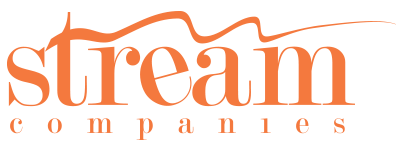Sal Sciarrino – Graphic Designer
Design is not just color and layout; it takes a well-written and presented message combined with effective imagery to create a powerful design. Typography can often make or break a design.
What exactly is typography?
Typography is the use of text and typographic elements in a design to communicate an idea a brand or a logo.
Typography is essential in making your piece stand out from the rest – it is your delivery system to keep your audience interested. Relying solely on an image can ultimately put you at a disadvantage. Images can be unclear, whereas words can clearly convey a message.
To drive home a message and really make it stick, here are a number of tips from the Design team at Stream Companies.
- Use size and boldness to underscore the importance of a message and distinguish its hierarchy.
- Use typography to convey the mood of your piece. – A script font can say romance, a classic serif font can portray a formal event or a high end product and a clean sans serif line can give a modern flare to any design piece.
Before starting any project, Stream Designers ask these questions:
- What is the purpose?
- What is the message?
- Who’s is the target market?
Once you have these questions answered, take a look at the following:
- Use your tools – Utilize the tools at hand such as your kerning, leading, tracking, and justification to make your type stand out and stay organized.
- Balance your design – Make sure your design is well balanced, clean and your message is easy to understand at a glance; you don’t want your message lost in a collage of images and clutter.
- Focus on the details – Attention to details are crucial. For example, making sure that letters aren’t hanging out unintentionally or dwarf words taking an entire line and not paying attention to line shifts.
- Font choice – Choosing complementary fonts to create a smooth and eye catching combination in design process will not only clean up your design, but it will make your message easier to read and understand.
- Don’t use too many fonts – Limiting the amount of fonts use in your piece to clear up the clutter. General rule – stick with 2 font families and use no more than 2 fonts per family. Using the paragraph and character style palettes in your layout program will ensure consistency across your document.
- Color – Color is important for type. Make sure that you are using colors that are easy on the eyes and complement the graphics in the piece. Using the eyedropper tool to grab a color directly from your imagery will ensure color consistency between your headline and main image. This will help with the flow of the piece as well as tying everything together.
- Positive and negative space – Utilizing positive and negative space not only creates a clean layout, but it clears up the clutter and makes your message stand out.
- Make it fun – Sometimes you have the dry and boring pieces to work with, but having fun with the design and typography can really bring these pieces to life. Add small incidentals and graphics to make certain things “Pop” or use colors to point out the important sections of the piece. Having fun with the design is why we do this every day!
Click each example of typography for a closer look!
